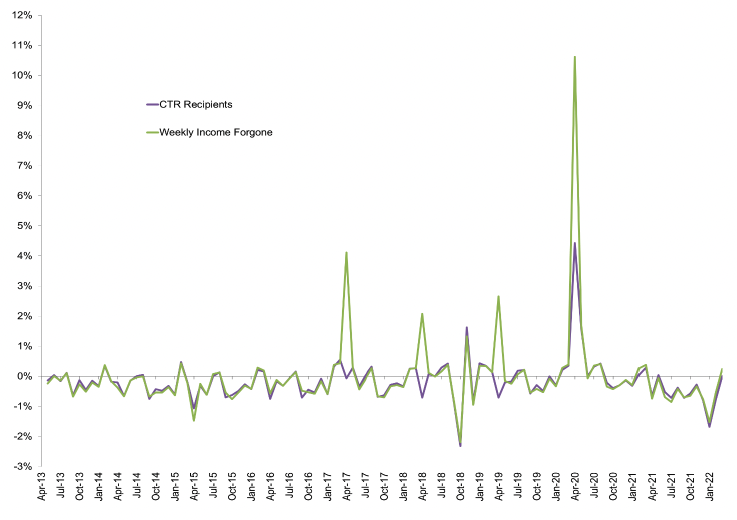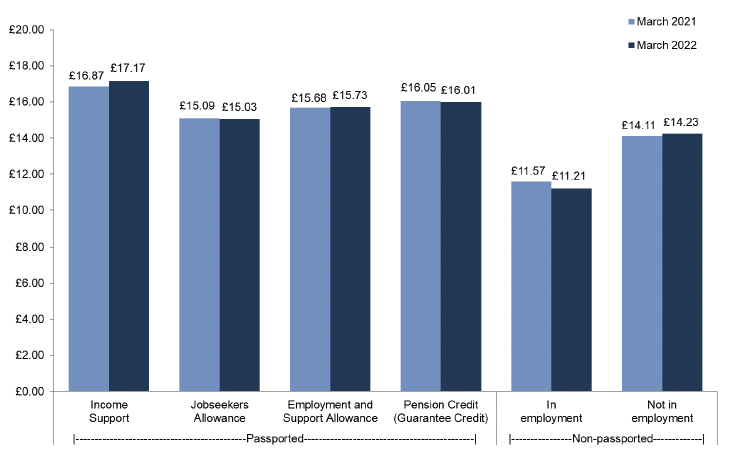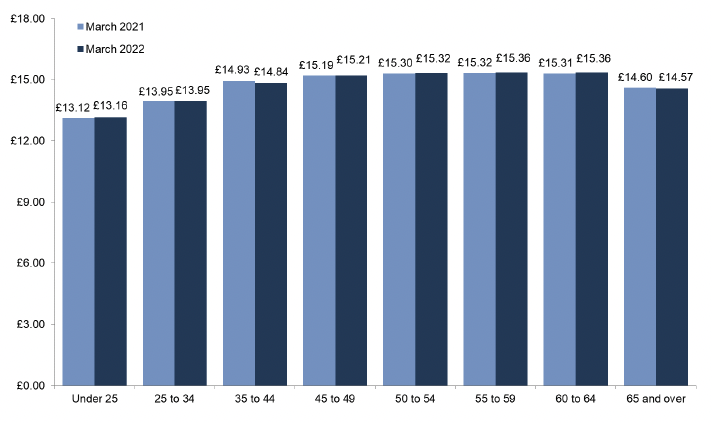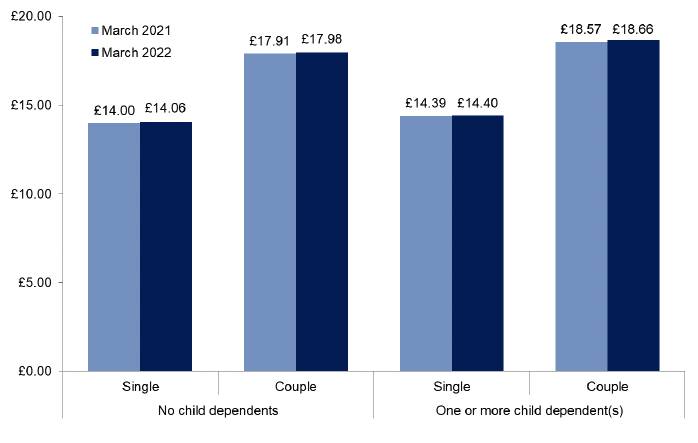Council Tax Reduction in Scotland: 2021-2022
Council Tax Reduction (CTR) awarded by age, household structure, income sources and employment status, deprivation index, and Council Tax band in the financial year from April 2021 to March 2022. It makes references to the previously published March 2021 for comparative purposes.
This document is part of a collection
3. Weekly Income Forgone Estimates
The CTR scheme reduces the amount of Council Tax a local authority can expect to receive, although the Scottish Government provides funding to each local authority to reflect that their Council Tax income is lower due to CTR. Weekly income forgone figures are reported monthly and the following section provides the most recent data. The weekly income forgone estimates are based on the number of CTR recipients multiplied by the average weekly CTR amount per recipient for each local authority and benefit type for the given month. When a household's Council Tax liability is reduced due to the CTR scheme, it reduces the amount of Council Tax a local authority can collect.
The total Council Tax weekly income forgone due to CTR was £6.829 million in March 2022, a decrease of 7 per cent compared to March 2021. This decrease is in line with the decrease in CTR recipients mentioned above during this period. Despite CTR numbers being almost the lowest ever recorded, the total weekly income forgone by local authorities due to CTR in March 2022 is still higher than pre-pandemic levels, though now slightly below the level observed at the start of the scheme. This is due to the fact that council tax increases lead to increases in the cost of the CTR scheme, as many households receiving CTR get a 100% reduction, the cost of which increases with rises in council tax.
A breakdown of the total weekly income forgone by each local authority between March 2021 and March 2022 is shown in Table 3. It can be seen that Glasgow City accounted for one-fifth (20 per cent) of the total weekly income forgone for Scotland followed by City of Edinburgh (7 per cent) and North Lanarkshire (7 per cent) in March 2022. This is consistent with the higher numbers of CTR recipients recorded for these local authorities and is similar to the proportions observed in March 2021.
| Mar-21 | Apr-21 | May-21 | Jun-21 | Jul-21 | Aug-21 | Sep-21 | Oct-21 | Nov-21 | Dec-21 | Jan-22 | Feb-22 | Mar-22 | % Change (Mar 21-Mar 22) |
|
|---|---|---|---|---|---|---|---|---|---|---|---|---|---|---|
| Scotland | 7,328.0 | 7,273.8 | 7,269.7 | 7,219.3 | 7,157.8 | 7,127.5 | 7,077.6 | 7,031.9 | 7,008.5 | 6,955.4 | 6,849.2 | 6,812.4 | 6,829.2 | -6.8% |
| Aberdeen City | 240.8 | 238.2 | 236.3 | 234.0 | 229.9 | 228.0 | 225.7 | 223.0 | 222.7 | 220.2 | 216.1 | 214.0 | 211.8 | -12.0% |
| Aberdeenshire | 193.5 | 190.9 | 189.5 | 187.8 | 183.3 | 181.5 | 180.3 | 179.9 | 178.6 | 182.9 | 176.0 | 172.4 | 173.3 | -10.4% |
| Angus | 113.3 | 113.6 | 112.4 | 112.4 | 111.3 | 110.2 | 109.5 | 109.0 | 108.5 | 107.3 | 106.0 | 105.4 | 104.7 | -7.6% |
| Argyll and Bute | 114.9 | 114.5 | 113.7 | 112.6 | 110.5 | 110.1 | 109.2 | 108.5 | 107.8 | 107.4 | 106.4 | 105.4 | 107.0 | -6.9% |
| City of Edinburgh | 558.0 | 555.7 | 552.7 | 547.3 | 541.0 | 541.0 | 540.0 | 536.1 | 530.9 | 521.1 | 509.7 | 508.7 | 504.9 | -9.5% |
| Clackmannanshire | 75.2 | 75.0 | 74.6 | 74.3 | 74.0 | 73.4 | 72.9 | 72.3 | 71.9 | 71.9 | 70.5 | 70.4 | 70.6 | -6.1% |
| Dumfries and Galloway | 191.8 | 191.0 | 189.6 | 188.0 | 185.3 | 183.1 | 184.4 | 183.4 | 183.0 | 180.4 | 176.9 | 177.1 | 177.2 | -7.6% |
| Dundee City | 253.0 | 253.5 | 251.9 | 253.2 | 255.0 | 255.9 | 255.4 | 254.1 | 253.5 | 248.8 | 243.0 | 242.2 | 243.9 | -3.6% |
| East Ayrshire | 195.8 | 194.7 | 193.6 | 193.6 | 191.9 | 191.6 | 189.9 | 187.8 | 188.4 | 187.9 | 185.8 | 183.7 | 184.5 | -5.8% |
| East Dunbartonshire | 99.4 | 99.1 | 98.0 | 97.8 | 96.3 | 96.4 | 95.3 | 95.0 | 95.2 | 94.6 | 93.3 | 92.8 | 93.6 | -5.8% |
| East Lothian | 109.8 | 109.6 | 109.8 | 108.9 | 108.8 | 109.0 | 108.3 | 108.0 | 107.5 | 106.7 | 106.0 | 105.2 | 103.6 | -5.7% |
| East Renfrewshire | 81.0 | 81.6 | 81.0 | 84.4 | 82.8 | 83.2 | 86.1 | 83.6 | 84.5 | 83.4 | 80.9 | 79.4 | 79.7 | -1.5% |
| Falkirk | 171.8 | 172.0 | 172.0 | 169.7 | 168.7 | 168.8 | 167.6 | 166.8 | 165.9 | 164.6 | 162.4 | 162.0 | 162.7 | -5.3% |
| Fife | 443.0 | 443.2 | 444.3 | 441.4 | 439.8 | 437.6 | 433.7 | 428.9 | 425.7 | 422.6 | 416.4 | 415.5 | 415.2 | -6.3% |
| Glasgow City | 1465.5 | 1452.4 | 1466.4 | 1458.6 | 1446.4 | 1448.7 | 1429.8 | 1422.2 | 1425.3 | 1414.3 | 1389.0 | 1381.2 | 1385.2 | -5.5% |
| Highland | 271.0 | 270.2 | 269.7 | 266.9 | 260.8 | 258.6 | 256.4 | 253.9 | 253.6 | 250.8 | 249.8 | 249.2 | 248.4 | -8.4% |
| Inverclyde | 134.5 | 134.2 | 133.6 | 132.2 | 132.1 | 132.4 | 131.1 | 131.6 | 131.8 | 131.5 | 129.6 | 128.0 | 127.7 | -5.0% |
| Midlothian | 102.0 | 102.5 | 101.9 | 101.0 | 100.6 | 99.8 | 98.2 | 98.0 | 97.7 | 97.5 | 96.7 | 96.4 | 96.3 | -5.6% |
| Moray | 82.8 | 82.6 | 81.7 | 80.7 | 80.0 | 79.8 | 79.2 | 78.6 | 77.5 | 77.0 | 76.1 | 75.9 | 76.3 | -7.8% |
| Na h-Eileanan Siar | 27.6 | 27.5 | 27.4 | 27.2 | 26.5 | 26.3 | 26.1 | 25.9 | 25.6 | 25.5 | 25.3 | 25.1 | 25.3 | -8.6% |
| North Ayrshire | 267.8 | 248.6 | 257.8 | 246.2 | 251.2 | 242.5 | 241.5 | 240.1 | 240.0 | 240.2 | 239.1 | 237.5 | 242.6 | -9.4% |
| North Lanarkshire | 491.9 | 490.6 | 487.9 | 485.1 | 480.7 | 479.1 | 475.5 | 472.7 | 469.4 | 465.4 | 461.5 | 455.3 | 459.0 | -6.7% |
| Orkney Islands | 19.1 | 18.9 | 19.0 | 18.9 | 18.0 | 17.8 | 18.4 | 18.1 | 18.2 | 17.4 | 16.7 | 16.5 | 17.5 | -8.3% |
| Perth and Kinross | 140.6 | 141.0 | 140.3 | 139.7 | 137.3 | 136.2 | 136.2 | 134.9 | 133.3 | 133.6 | 131.6 | 131.1 | 131.6 | -6.4% |
| Renfrewshire | 283.1 | 280.2 | 276.8 | 275.0 | 272.0 | 270.3 | 268.2 | 267.1 | 266.6 | 264.7 | 258.0 | 255.9 | 254.8 | -10.0% |
| Scottish Borders | 118.4 | 116.6 | 116.1 | 115.1 | 113.9 | 112.7 | 111.3 | 110.1 | 109.2 | 108.7 | 108.5 | 106.9 | 105.4 | -10.9% |
| Shetland Islands | 15.6 | 15.2 | 15.0 | 15.1 | 15.0 | 14.8 | 14.6 | 14.6 | 14.6 | 14.6 | 14.2 | 14.1 | 14.6 | -6.0% |
| South Ayrshire | 170.0 | 169.9 | 168.6 | 167.6 | 166.2 | 165.3 | 164.6 | 164.6 | 163.8 | 161.9 | 159.8 | 160.4 | 160.2 | -5.8% |
| South Lanarkshire | 426.6 | 425.1 | 421.8 | 417.7 | 416.8 | 413.8 | 410.9 | 408.3 | 405.7 | 402.6 | 397.7 | 400.5 | 406.4 | -4.7% |
| Stirling | 87.7 | 87.5 | 87.4 | 86.4 | 85.3 | 85.1 | 85.2 | 85.1 | 84.7 | 84.1 | 83.8 | 84.0 | 82.9 | -5.5% |
| West Dunbartonshire | 169.8 | 167.2 | 168.5 | 170.5 | 170.1 | 169.5 | 168.7 | 168.1 | 167.9 | 168.0 | 166.6 | 165.2 | 165.7 | -2.4% |
| West Lothian | 212.9 | 211.1 | 210.6 | 210.0 | 206.5 | 205.2 | 203.3 | 201.4 | 199.7 | 198.0 | 195.8 | 195.4 | 196.7 | -7.6% |
3.1 Weekly income forgone over time
The total weekly income forgone estimates for Scotland (see section 5 for more details) have decreased from £7.092 million in April 2013 to £6.829 million in March 2022. The income forgone estimates follow the same general pattern as the number of CTR recipients, with the exception of April 2017, 2018 and 2019 where there was a large increase in the income forgone from the previous month as a result of an increase in Council Tax between March and April of each year (as shown in Chart 1 on page 1). In April 2020 there was a large increase in both the number of CTR recipients and income forgone due to the economic impacts of the Covid-19 pandemic whilst in April 2021, Council Tax rates were frozen so there were no resultant increases associated with Council Tax increases at that time.
Until March 2020, all local authorities had seen a decrease in their weekly estimates of CTR income forgone since April 2013, driven by a decrease in CTR recipients, with the exception of Aberdeenshire whose weekly estimate of CTR income forgone had increased by just over £10,000 in March 2020 (after a reported rise of just under £5,000 in March 2019) when compared to April 2013.
The number of CTR recipients and weekly income forgone have been closely linked, with most of the variability in income forgone being driven by the number of CTR recipients. However in April 2020, the weekly income forgone increased sharply by 10.6 per cent from the previous month as a result of the annual increase in Council Tax but also the increase in CTR recipients (4.4 per cent) as a result of the initial economic impacts of Covid-19 resulting in more claimants and therefore recipients of the CTR scheme. This is the largest monthly rise for both weekly income forgone and CTR recipients since the CTR scheme began. As a result, the weekly income forgone in March 2021 was higher than when the scheme began in April 2013.
In March 2022, almost four-fifths of local authorities had seen a decrease in their weekly estimates of CTR income forgone since the scheme began, with Edinburgh City's weekly estimate of CTR income forgone almost £50,000 less in March 2022 than when compared to April 2013.
Chart 15 shows the month-on-month percentage changes in the number of CTR recipients and the weekly income forgone for April 2013 to March 2022. Rather than a sustained increase in income forgone, the chart spikes in April annually since 2017 (whilst the numbers of CTR recipients continue to decrease) due to changes in Council Tax. After the increases in Council Tax, the month-on-month comparisons decrease and follow previously observed patterns with the exception of 2020 where the number of recipients and weekly income forgone continued to rise and peaked in August 2020 due to the economic impact of Covid-19. Chart 15 also shows small peaks in the number of CTR recipients and weekly income forgone at the beginning and middle of each calendar year, indicating a possible seasonal effect.

The Recipients and Income Forgone tables, previously published (24 May 2022) for the March 2022 data release, show a decrease in the on-going costs of the scheme compared to March 2021 but is still higher than pre-pandemic levels, though now slightly below the level observed at the start of the scheme. This is due to the fact that CTR numbers have generally decreased in 2021-22 likely driven by economic and employment conditions recovering after the pandemic and therefore the cost of the scheme has also decreased. Other factors that affect the total income forgone by local authorities include age, structure of the population and household income.
The weekly income forgone estimate for each local authority for each month between April 2013 and March 2022 are also provided in the Recipients and Income Forgone tables.
3.2 Average weekly awards by passported status
In March 2022, the average weekly award per CTR recipient was £14.76 per week (resulting in average savings of over £750 a year on Council Tax for CTR recipients), the same as in March 2021. After the increases in Council Tax rates in April 2020 and a sharp rise in CTR recipients as a result of the initial economic impacts of Covid-19, the average weekly award remained around the same levels during 2021-22 decreasing to £14.67 between the months of October 2021 and December 2021.
Average weekly award per CTR recipient varied by both local authority (ranging from £12.88 to £17.37) and passported status in March 2022. These figures are included in the supplementary tables.
Of passported benefits, Income Support and Employment Support Allowance CTR recipients saw increases in average weekly awards per CTR recipient in March 2022 compared to March 2021 whilst Job Seekers Allowance and Pension Credit CTR recipients observed a slight decrease over the same period. Chart 16 shows the average weekly award per CTR recipient by passported status. Some key variations are:
- Non-passported CTR recipients who were not in employment increased (£0.12) in average award in 2021-22.
- Non-passported CTR recipients who were in employment received the least on average per week at £11.21 (having decreased the most by 36 pence compared to March 2021). Those on Income Support received the most at £17.17.
- Passported income forgone will generally be higher (£15.94 in March 2022), by virtue of being on a passporting benefit. These CTR recipients will be in receipt of full CTR in almost all cases compared with £13.80 for non-passported CTR recipients in March 2022.

The average weekly award by passported status and by local authorities are provided in the supplementary tables.
3.3 Average weekly awards by age and family type
Chart 17 shows the average weekly income forgone estimates by age group which has recorded a slight increase in most age categories in March 2022. The under 25 age category had the lowest average weekly award at £13.16 which was also the lowest average weekly award in March 2021. The average weekly income forgone estimate is generally higher at each age category until the 60 to 64 category was reached at which point it decreased.

Chart 18 shows the average weekly award by family type in March 2022 which has recorded an increase in all family categories since March 2021. It can be observed that couples generally have a higher average weekly award than single adults. Single adults with no child dependents received the lowest average weekly award at £14.06 compared to couples with dependent children who had the highest average weekly award at £18.66.

Contact
Email: eddie.chan@gov.scot
There is a problem
Thanks for your feedback